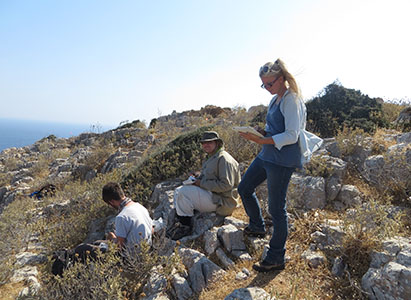Kea
Field School

Duration: six weeks
Credits: six credits from UNCG
KARS Field School takes place on the picturesque Cycladic Island of Kea which is located one hour by ferry from the Athenian port of Lavrion.
Through participation in a field school students get to grasp the academic facts given to them at the university in a more comprehensive and tangible manner, and grasp a fuller picture of how the past is recreated. On this field school, the students are immersed in an international, professional, archaeological setting and they learn how to conduct an archaeological project, how to observe archaeological material, how to document and record it, and how to analyze it. The skills that the students learn on this project – working on a team, professionally communicating with your peers and staff, documenting your observations, and paying attention to detail – are transferable skills that will help the students both at university and when they enter their professional lives.
The first week of the Field School is spent touring major archaeological sites. We spend three days in Athens and visit the Acropolis site and museum, the agora, Hadrian’s Library, the Roman Agora, the Temple of Olympian Zeus, the Kerameikos, and the National Musuem. We then head south to the Corinthia and the Argolid where we visit the Panhellenic sites of Isthmia and Nemea, Ancient Corinth, Mycenae, Tiryns, and the Nauplion Museum. This element of the field school gives the students an overview of Greek archaeology, before we start fieldwork on Kea. By having the tour before we start field work, the staff and students have the opportunity to familiarize themselves with each other, which leads to a more effective selection of field teams.
On Kea the students are an integral part of a large research project that examines the impact of changing landscapes on archeological surface survey. They have several tours and lectures from a variety of experts who participate in the project and the students have the opportunity to work with these specialists during the project on artifacts such as pottery, lithics, and architecture. On the island the students are trained in all aspects of field walking and data recording from simple tasks of measuring their stride length and using a compass, to the more complicated ones of describing the land use, and using iGis and File Maker Pro. They participate in the field walking of the project where they identify and collect diagnostic pottery sherds, lithics (worked stone) and slag (waste from metal production). They also train and participate in the processing of finds at the apotheke (find storerooms). All the field walking and apotheke (lab/find processing center) work is done in teams, which ultimately helps the students to interact with one another in ways that do not occur in the classroom. When you are hiking through thick thorny vegetation up a steep hill, the need for the co-operation of your team-mates becomes starkly apparent!
Students that excel on the field school are invited back to return as either field team or apotheke (lab/find processing center) assistants.
Thus far students from four universities have participated in the field school: UNCG, Trinity College Dublin, the University of Cincinnati, and the University of Akron. In 2012 we had 15 students and in 2013 we had 23 students, including 5 students who returned as assistants. In 2014, we plan to take 28 students, including 6 returning students as assistants, in order to complete our field walking and focus on Phase II pick ups of sites (See methodology).





